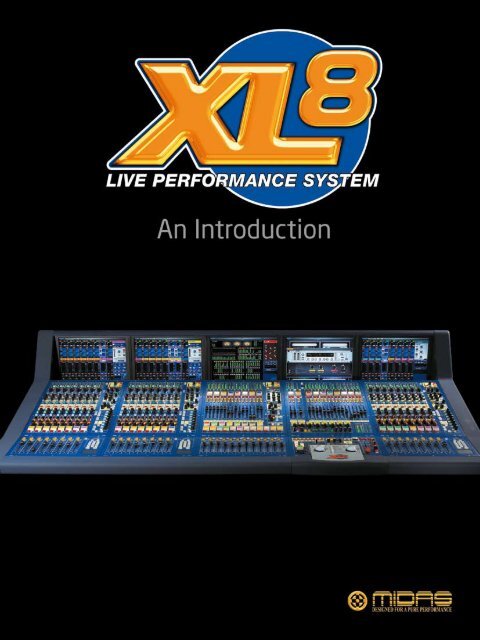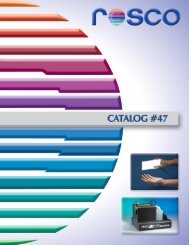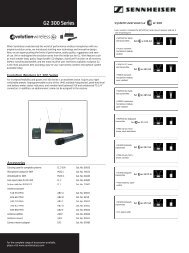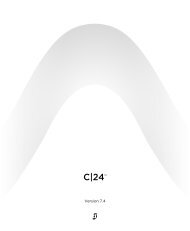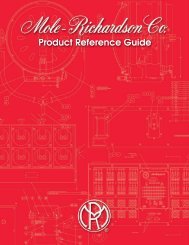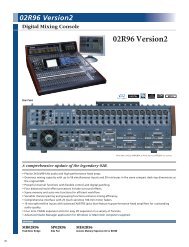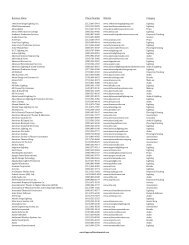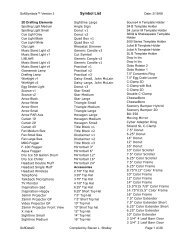Midas- xl8-brochure.pdf - stagecraft fundamentals
Midas- xl8-brochure.pdf - stagecraft fundamentals
Midas- xl8-brochure.pdf - stagecraft fundamentals
You also want an ePaper? Increase the reach of your titles
YUMPU automatically turns print PDFs into web optimized ePapers that Google loves.
Introduction: a new standard for live mixing.<br />
[Revolutionary - rev·o·lu·tion·ar·y adv.<br />
adj : markedly new or introducing radical change;]<br />
The XL8 live performance system is truly revolutionary<br />
and heralds <strong>Midas</strong>’ entry into the digital mixing realm.<br />
However, this is not merely another digital mixing console.<br />
XL8 offers an incomparable design combining exemplary<br />
sound quality, flexibility and reliability with an ease<br />
and familiarity of use unrivalled by other digital control<br />
surfaces. XL8 is the first of a new generation of openarchitecture,<br />
cross-platform, integrated audio control and<br />
distribution systems, which brings control of not only<br />
audio, but other aspects of a live performance to a single,<br />
intuitive control centre.<br />
As well as offering classic <strong>Midas</strong> audio quality and superb reliability, XL8 actually<br />
improves upon the performance of the analogue consoles, which have established<br />
<strong>Midas</strong> as the number one choice of sound engineers the world over. XL8 represents<br />
a new generation of networked systems, requiring only mics, amps and speakers to<br />
provide a complete audio system.<br />
The XL8’s open architecture ensures that both third-party hardware and software,<br />
including “plug-ins” can be easily integrated into the system. The very latest in highspeed<br />
networking technology ensures that XL8 will conform to all the classic <strong>Midas</strong><br />
brand values of sound quality, reliability and longevity; it will not be obsolete in<br />
a few years.<br />
XL8 Live Performance System Overview<br />
• Failure-tolerant of any single failure of hardware or software<br />
• Proven, stable, Linux operating system<br />
• Dual redundant master control processors<br />
• Five individual bay control processors<br />
• 24/7 global telephone support<br />
• <strong>Midas</strong> customer service and support centres in Minneapolis (USA),<br />
Kidderminster (UK), Japan and Singapore<br />
• Three year factory warranty<br />
• Rugged design, tolerant of physical abuse!
XL8 Control Centre: don’t change the way you think.<br />
As can be expected from the design team at <strong>Midas</strong>, the<br />
XL8 has been painstakingly designed to address the way<br />
in which sound engineers approach the task of mixing. The<br />
control centre can be operated from scratch quickly and<br />
easily – even by engineers new to digital control surfaces.<br />
XL8 has been designed so the engineer does not have to think in terms of numbers,<br />
pages or layers. Users navigate the system and identify channels by colours and<br />
groupings, which they themselves create. This method allows an individualised approach<br />
to mixing, rather than working within hardware-dictated numerical limitations. This<br />
reassuringly familiar way of working is central to the XL8 and ensures that engineers do<br />
not have to change their way of thinking to feel comfortable with the new system.<br />
Each of the five bays of the console is a discrete hardware module, which is independent<br />
of its neighbour and incorporates its own power supply, surface processor, GUI processor<br />
and screen. The only common connection is via a single Ethernet link to the network.<br />
The standard 5-bay control surface comprises a total of five of the following three<br />
modules:<br />
• 3 x Input module<br />
• 1 x Mix module<br />
• 1 x Output module.<br />
In addition to placing engineers in a familiar comfort zone, which allows them to get<br />
on with the job of making great audio without worrying about the rigours of new<br />
technology, the XL8 also comes complete with a range of features unique in the world<br />
of live mixing.<br />
Control Centre Overview<br />
• Dedicated motor faders on outputs<br />
• Paged controls do not change function (e.g. a gain knob is always a gain knob –<br />
never a frequency knob!)<br />
• Silky smooth, high accuracy rotary controls<br />
• Dedicated discrete hardware remote control for onboard Graphic EQs with the Klark<br />
Teknik Rapide<br />
• Modular control surface with multiple input areas - easily accommodates<br />
multiple operators<br />
• Two routers in the control centre in addition to the two DL461 Audio System<br />
Signal Routers<br />
• Daylight visible DVI TFT display screens<br />
• Three way KVM (keyboard, video, mouse) remote control of any ‘Mac ‘ or ‘PC’ from the<br />
control centre<br />
• White LED lighting of the control centre surface<br />
• 63 discrete 20-segment LED meters<br />
• Discrete LED meters for dynamics and direct outs<br />
• “All the meters all the time” master status screen<br />
• Simple, visible hardware routing to master outputs
XL8 Input Module:<br />
The input module consists of an 8-channel “fast zone”,<br />
where an operator will find the “must have now” controls, a<br />
detailed channel strip which is the interface with all of the<br />
selected channel’s control parameters and a display screen.<br />
A standard 5-bay frame has three input modules, which<br />
allow easy access for multiple operators.<br />
Input Module Overview<br />
• Three discrete <strong>Midas</strong> mic pre amps per mic input (e.g. FOH, Monitor, Broadcast)<br />
- no gain sharing<br />
• Analogue and digital gain controls for optimisation of preamp performance and<br />
channel gain structure<br />
• <strong>Midas</strong> EQ sound quality and “control feel”<br />
• <strong>Midas</strong> dynamics with choice of four styles (including Vintage)<br />
• <strong>Midas</strong> quality input and output CMRR and drive capability<br />
• Unique Muscle Memory friendly E-Zone layout for EQ<br />
• Unique Muscle Memory friendly D-Zone layout for dynamics<br />
• Fast Zone for instant access to key channel parameters<br />
• Eight channels of key data and single channel full detail on each input screen<br />
• Area A and area B free assignment<br />
• External video in and out - enables an operator to view external computers / video on<br />
each input screen<br />
Each of the 96 full-function input channels has:<br />
• Analogue and digital gain<br />
• Phase reverse switch<br />
• Phantom power<br />
• Input delay<br />
• Swept high pass filter with choice of two filter slopes<br />
• Swept low pass filter with choice of two filter slopes<br />
• Frequency-conscious compressor with choice of 4 compression styles<br />
• Frequency-conscious noise gate with external sidechain<br />
• Insert point<br />
• Treble EQ filter with choice of four filter types<br />
• Parametric hi-mid EQ filter<br />
• Parametric lo-mid EQ filter<br />
• Bass EQ filter with choice of four filter types<br />
• Routing via level controls to 32 AUX mix busses and 16 Matrix busses (FOH mode) or<br />
48 foldback mixes (Stage Monitor mode)<br />
• Routing via pan control to left and right master busses<br />
• Routing to mono master buss<br />
• Pan pot (SIS)<br />
• Direct output
XL8 Mix Module:<br />
The mix module features the aux inputs, mix masters, VCA<br />
faders, POP group select buttons, mix group select buttons,<br />
mix buss detail panel and a display screen. A standard 5-bay<br />
frame has one mix module.<br />
Mix Module Overview<br />
• 12 VCA (Variable Control Association) groups<br />
• 8 POP (population) groups<br />
• External video in and out<br />
Each of the 32 auxiliary mix busses has:<br />
• Subgroup, Auxiliary or Mix minus modes<br />
• Dual mono or stereo pair modes<br />
• 6-band parametric EQ<br />
• Optional 31 band GEQ (replaces PEQ)<br />
• Frequency-conscious compressor with soft clip limiter and choice of<br />
5 compression styles<br />
• Insert point<br />
• Routing via level controls to the 16 matrix busses<br />
• Routing via pan control to the Left, Right and Mono master busses<br />
• Direct input<br />
Each of the 16 auxiliary inputs has:<br />
• Input gain<br />
• Source from internal FX or external pool input<br />
• Fader<br />
• Pan pot (SIS)<br />
• Routing via level controls to the 16 matrix busses<br />
• Routing via pan control to the Left, Right and Mono master busses<br />
XL8 Output Module:<br />
The output module features the main (matrix) mix<br />
masters, automation control, dual trackball control panel,<br />
slide-out keyboard, communications panel, monitoring<br />
control and a display screen. A KVM (keyboard, video and<br />
mouse) switch is incorporated into this bay, to enable<br />
an operator to view and control up to three external<br />
computers from the control centre. A standard 5-bay frame<br />
has one output module.<br />
Output Module Overview<br />
• Full capability theatre style scene automation<br />
• Snapshot scene automation has cross-scene global edit capability<br />
• System can operate with show files written on earlier and later versions of firmware<br />
• Separate automation scope screens for scene store and recall<br />
• KVM (keyboard, video and mouse) switching on control surface allows the<br />
operation of any ‘Mac’ or ‘PC’ based third party software from the XL8<br />
• Discrete dual solo systems<br />
• 8 user assignable controls<br />
Each of the 16 matrix busses has:<br />
• 6-band parametric EQ<br />
• Optional 31 band GEQ (replaces PEQ)<br />
• 5-mode frequency-conscious compressor with soft clip limiter and external sidechain<br />
• Insert point<br />
• Direct input<br />
• Mix minus mode<br />
Each of the master output busses has:<br />
• 6-band parametric EQ<br />
• Optional 31 band GEQ (replaces PEQ)<br />
• 5-mode frequency-conscious compressor soft clip limiter and with external sidechain<br />
• Insert point<br />
• Direct input
XL8 Audio System Signal Processor (DL471)<br />
The DL471 is a 1U 19” rack unit, which forms part of the modular DSP engine. It features its own discrete power supply, AES50 and Ethernet control interfaces, as<br />
well as a dual, ultra high-speed, contra-rotating data loop for direct processor to processor communications. Each XL8 system includes ten DL471 units of which<br />
one is a redundant spare (n+1 resilience model).<br />
DSP Engine Overview<br />
• 10 DL471s included in an XL8 live performance system<br />
• Automatic deployment of spare in event of DSP engine failure<br />
• Advanced FPGA architecture<br />
• Exclusive <strong>Midas</strong> processing algorithms<br />
• Composite engine capable of 48,000 million calculations per second<br />
XL8 Audio System Signal Router (DL461)<br />
The DL461 is a 3U 19” rack unit, which performs the stage-to-console link using a single CAT6 cable (under 100 metres) or fibre-optic link (up to 500 metres). In<br />
addition to audio and control connections to the ten DSP modules, it features ten fully dual redundant AES50 ports (480 digital audio connections), as well as<br />
75R and AES3 word clock interfaces, and Ethernet tunnel. Dual redundant DL461’s are supplied with each XL8 system.<br />
Network Features<br />
• 2 DL461s included in an XL8 live performance system<br />
• Integrated open-architecture AES50 digital audio distribution<br />
• Fully duplicated network for redundancy<br />
• Up to 100 metres of dual redundant connectivity between hardware elements (copper); up to 500m using optical fibre<br />
• Automatic integral delay management system - audio outputs time and phase coherent<br />
• Flexible, expandable hardware system<br />
• Ethernet TCP-IP & USB tunnelling for third parties<br />
• 1,000 million bits per second data transfer<br />
XL8 Audio System Modular I/O (DL451)<br />
The DL451 is a 3U 19” rack unit, which provides a maximum of 24 audio inputs and 24 audio outputs. It has a user-configurable 3x8 XLR format, which can be<br />
configured as analogue mic/line in, analogue out, or digital in/out (AES/EBU). Midi in, out & through, and GPIO connections are supplied as standard. Digital<br />
audio interface is via dual-redundant AES50 ports.<br />
DL451 Overview<br />
• 5 DL451s included in an XL8 live performance system, up to a further 9 DL451s can be added into the system
XL8 Audio System Input Splitter (DL431)<br />
The DL431 is a 6U 19” rack unit which provides 24 mic/line inputs. Each input feeds three separate preamps, two with separate remote and local gain controls,<br />
the third being fixed gain. The two preamps with gain controls feed separate ADCs which pass digital audio to the network. Four discrete AES50 outputs supply<br />
dual redundant digital audio to FOH and monitor XL8 systems and allow for easy routing to any third party AES50 device (eg HD recorder), via the DL461 routers.<br />
Two balanced analogue splits (sourced post each mic amp) are provided on the rear panel. The third, fixed gain, preamp feeds a transformer isolated split on the<br />
front panel for recording or broadcast applications.<br />
DL431 Overview<br />
• 4 DL431s included in a XL8 live performance system<br />
• Front-panel control and local monitoring (can be used as a stand alone unit)<br />
• Integral headphone amplifier<br />
• Dual Ethernet ports ( e.g. for stand alone remote control)<br />
• USB connections for USB tunnelling of third party serial data<br />
• Dual integral power supplies<br />
• Integrated three way analogue mic splits<br />
Klark Teknik DN9331 Helix Rapide<br />
The DN9331 is a 6U 19” rack unit and is a motorised fader remote control for the XL8’s onboard Graphic EQs. It connects using a single Ethernet cable and<br />
provides instant real-time control of all onboard assignable graphic equalisers, via the Solo Tracking System (STS) .<br />
DN9331 Overview<br />
• 1 DN9331 is included in a XL8 live performance system<br />
• 31 100mm console-grade motorised faders<br />
• 4 banks of 32 channels each<br />
• 4 user-configurable GEQ groups<br />
• Global mode<br />
• Rack mounting or free standing<br />
• Simultaneous control of XL8 onboard and Klark Teknik Helix digital EQ units
XL8 Network Overview:<br />
The XL8’s <strong>Midas</strong>NET network uses the physical connectivity of Ethernet<br />
(Ethercon connectors and CAT5/6 cable), but NOT the data protocol, which is<br />
too slow for high-quality, low-latency audio distribution.<br />
All digital audio is transmitted using the AES50 protocol (implemented as Sony<br />
SuperMac) and the Sony HyperMac high-capacity system. AES50 is an openarchitecture<br />
protocol and HyperMAC is a standards candidate. These protocols<br />
benefit from extremely low latency, robust feed-forward error correction,<br />
and advanced system clocking. The use of this AES standard means simple,<br />
straightforward interfacing with ANY 3rd party hardware which feature this<br />
connection.<br />
<strong>Midas</strong>NET connections carry digital audio, control data, and standard Ethernet<br />
traffic, bi-directionally, down a single cable. CAT5 for “local” (24 channel)<br />
connections, and a single CAT6 (or fibre-optic) for the digital “snake”, which is the<br />
equivalent of a 384 channel analogue multicore!<br />
The benefit of combining audio, control, clock and third party Ethernet data into<br />
one single network means the XL8 hardware interfaces on a single<br />
RJ45 connection.<br />
The XL8 also runs self diagnostic software in the background in real time<br />
measuring important hardware performance such as processor temperatures,<br />
error correction rates and connection integrity. Any unusual variances are<br />
instantly notified to the user before any audible issues occur.<br />
All network connections are duplicated for full dual-redundancy.<br />
The XL8 and <strong>Midas</strong>NET run at 96kHz sample rate. Each network link has a<br />
latency of only 70μS. Typical total system latencies are 2mS. Comprehensive<br />
management of delays are provided, including automatic compensation for<br />
insert points.<br />
XL8 System Interconnections:<br />
This diagram illustrates how compact a front of house and stage monitor XL8 system set up is, including both main and back up networks.<br />
I/O units (outs)<br />
Routers<br />
I/O units (outs)<br />
Routers<br />
Shared Mic Splitters<br />
DSP units<br />
Stage<br />
Located FOH<br />
Equipment<br />
Monitor<br />
DSP units<br />
Local I/O units<br />
Local I/O units<br />
Key<br />
24 channel bi-directional <strong>Midas</strong>NET<br />
main<br />
duplicate<br />
FOH<br />
Multiple <strong>Midas</strong>NET links<br />
main<br />
duplicate<br />
192 channel bi-directional <strong>Midas</strong>NET trunk link<br />
main<br />
duplicate
<strong>Midas</strong> DL431 Audio System Input Splitter<br />
Statistics:<br />
The audio physical connections i.e. audio XLR count<br />
Dedicated XLR connections:<br />
96 x mic/line inputs via DL431 mic splitter<br />
2 x 96 analogue mic splits with variable gain<br />
1 x 96 transformer isolated analogue “broadcast” mic split – fixed gain<br />
Configurable audio XLR connections:<br />
An XL8 is supplied with 5 DL451 I/O units each of which can be freely located at<br />
FOH or on stage. Each DL451 has three plug-in modules with 8 XLR’s on each.<br />
Three types of plug-in module are currently available:<br />
8 analogue mic/line in<br />
8 analogue out<br />
8 AES/EBU XLRs (giving 8 digital inputs and 8 digital outputs per module)<br />
The total audio XLR count for a standard XL8 is 504.<br />
The standard XL8 has a total (configurable) audio connection count of between<br />
120 and 240 depending on the mix of analogue and digital I/O. (NB this<br />
excludes the non-configurable 96 Mic inputs on DL431).<br />
Typical configuration would be:<br />
16 Mic/line auxiliary inputs (giving a total of 112 mic inputs as standard!)<br />
32 aux/group buss outputs<br />
16 matrix (main) outputs<br />
1 stereo main output<br />
1 mono main output<br />
2 stereo local monitor outputs<br />
This totals 71 audio connections leaving a further 169 (if everything is digital)<br />
or 49 (if everything is analogue) audio connections. These can be used for<br />
insert sends, insert returns, direct outputs, buss direct inputs and side chain<br />
connections.<br />
The maximum count of any one type of connection is:<br />
96 input insert sends<br />
96 input insert returns<br />
96 input compressor external sidechain connections<br />
96 input noise gate external sidechain connections<br />
96 input direct outputs<br />
51 mix buss insert sends<br />
51 mix buss insert returns<br />
51 mix buss direct inputs<br />
1 talk MIC input<br />
However the XL8 can have much more than the standard connectivity<br />
by adding DL451 I/O units! There are NINE spare AES50 connections (fully<br />
redundant) available. This means that potentially another 432 audio connections<br />
can be achieved (subject to other system limits).<br />
This gives a maximum XLR count of 720 for XL8.<br />
Due to the company policy of continual improvement we reserve the right to change the specifications of any <strong>Midas</strong> product without prior notice.
<strong>Midas</strong> XL8 Live Performance System:<br />
Quick Mix Guide<br />
Fast zone and detail panel areas<br />
The input module is divided into two areas, the “fast zone” (the eight channel<br />
strips to the left on the input bay), where all of the “must have now” controls<br />
are located, and the detailed channel strip (the vertically orientated channel on<br />
the right on the input bay), which gives more comprehensive control. Visual<br />
feedback for both areas is provided from the screen above. Scroll the input<br />
modules’ view using scroll buttons above the keypad, until the desired channels<br />
appear on the screen.<br />
Digital signal path and input routing<br />
Once the digital network is configured, the default state of the system is for<br />
input 1 on mic box 1 to be routed to channel 1 on the control surface. This<br />
follows through to channel 24, at which point input 1 on mic box 2 routes to<br />
channel 25, through to 48, etc.<br />
Setting the input gains<br />
The XL8 has two input gains, one is the remote analogue gain for the mic box,<br />
the other is a digital trim. Both are set from the common gain rotary, using the<br />
“gain swap” button to select analogue gain or digital trim. Select the analogue<br />
gain, and set input level for desired preference. Once this is achieved, select<br />
digital trim and set for preferred gain structure. The gain rotary in the detail area<br />
always controls the alternative “swap” to the fast zone.<br />
Routing to master stereo outputs<br />
Press the “stereo” button above the “image” rotary on the fast zone, check<br />
nothing is muted and the master faders are up, you will have audio!<br />
Input equalisation (E-zone)<br />
Switch the EQ section in using the button on the fast zone. Select desired filter<br />
using fast zone navigation buttons, or E-zone nudge buttons (found in the detail<br />
panel). Use filter controls in E-zone to apply EQ. The “mode” switch selects the<br />
filter types for the high and low shelving filters individually. Variable high and<br />
low pass filters are located next to the mic gain in the detail area, both feature a<br />
choice of two filter slopes. Visual feedback for EQ is provided from the screen, a<br />
graphical representation of the filters is shown above the detail area.<br />
Setting an AUX preset<br />
Aux presets are created to enable an operator to “lock” the most relevant pair of<br />
aux or matrix sends to each channel, on a scene-by-scene basis.<br />
Press and hold the “preset” button in the detail panel. Scroll through the 48 mix<br />
busses using the “scroll pair” buttons in the aux assign area. Press the aux select<br />
button in the fast zone when the required pair of mixes appears at each channel.<br />
Release the “preset” button to confirm selections. The preset will be displayed<br />
whenever the preset button is pressed. Mix send rotary controls will display the<br />
default colour of the selected busses.<br />
Building the FX rack<br />
Press the “effects” button on the trackball area (output module). You will be<br />
presented with an empty 19” rack on the screen above. Using the right-hand<br />
trackball, click on one of the blank rack panels, click on the “change device type”<br />
button at the top of the blank rack panel. Select your desired effects processor<br />
from the menu, then click the “ok” button to load it into your effects rack. Click<br />
on the front panel of your effect to open a processor for editing, use the buttons<br />
and rotary controls immediately below the matrix output faders for<br />
parameter entry. You need to look no further than the XL8 effects rack for the<br />
best in performance enhancing creative processing.<br />
Get Going<br />
Now you know all you need to get a great mix out of the XL8. Most importantly,<br />
you do not have to modify your approach to mixing in any way to enable you to<br />
enjoy operating the XL8. Truly good technology is easy to use.<br />
The <strong>Midas</strong> XL8 - a new standard for live mixing.<br />
Input dynamics processing (D-zone)<br />
Switch dynamics processors in using the buttons on the fast zone. Select desired<br />
process (Comp or gate) using fast zone navigation buttons, or D-zone nudge<br />
buttons (found in the detail panel). Use controls in D-zone to apply processing.<br />
Mode switch selects from a choice of four compressor styles, visual feedback<br />
for both comp and gate is provided from the fast zone hardware meters, the<br />
dashboard meters, and the screen above the appropriate input.<br />
VCA-centric mixing and POPulation (POP) groups<br />
The VCA-centric method of mixing was conceived around the way engineers<br />
use visual recognition to navigate around a desk, rather than memorising<br />
channels in numerical sequences. XL8 has been designed so the engineer<br />
doesn’t have to think in terms of numbers, pages or layers. Users navigate the<br />
system and identify channels by colours and groupings, which they themselves<br />
create. VCA-centric mixing allows an individualised approach to the system,<br />
rather than working within hardware-dictated numerical limitations. This<br />
reassuringly familiar way of operating is central to the console, and ensures that<br />
engineers don’t have to change their mindset to be able to mix on the XL8.<br />
Assigning to VCAs (variable control association)<br />
Press and hold desired VCA select button. Press channel select buttons to assign<br />
to VCA. Release VCA select button to confirm selections. The assigned input<br />
channels will adopt the VCA’s (user defined) colour as a default (this can<br />
be edited).<br />
Assigning to POP (population) groups<br />
Population groups are created to bring a user-configured group of input<br />
channels to a desired area of the control centre, for viewing or adjustment.<br />
Press and hold desired POP group select button. Press channel select buttons<br />
to assign to POP group. Release POP group select button to confirm selections.<br />
The assigned input channels will adopt the POP groups (user defined) colour as<br />
a default (this can be edited).
Quick mix guide key<br />
Matrix<br />
Select<br />
Buttons<br />
Monitoring<br />
Matrix Output Faders<br />
D-zone<br />
E-zone<br />
AUX /<br />
Group / Returns<br />
Select Buttons<br />
POPulation<br />
Groups<br />
VCA Select<br />
Buttons<br />
VCA Faders<br />
D-zone<br />
E-zone<br />
Master Output<br />
Faders<br />
User Assignable<br />
Controls<br />
Mute Groups<br />
Automation<br />
OUTPUT BAY<br />
Output Channel Strip<br />
INPUT BAY (3 per XL8)<br />
MIX BAY<br />
Fast Zone<br />
Input Channel Strip<br />
AUX / Group<br />
Output faders
A A A<br />
A A<br />
A<br />
A<br />
A A A<br />
A A A A<br />
A<br />
XL8 Control Centre Dimensions:<br />
1731.00 [68.15"]<br />
1875.00 [73.82"]<br />
346.00 [13.62"]<br />
591.50 [23.29"]<br />
963.84 [37.95"]<br />
837.71 [32.98"]<br />
307.33 [12.10"]<br />
420.80 [16.57"]<br />
66.00 [2.60"]<br />
38.50 [1.52"]<br />
691.94 [27.24"]<br />
961.79 [37.87"]<br />
1029.03 [40.51"]<br />
1054.27 [41.51"]<br />
Please Note:<br />
The depth of all 19 inch rack units are<br />
410mm/16.14” including rear rack ears or<br />
378mm/14.88” without rack ears.<br />
<strong>Midas</strong>, Walter Nash Road, Kidderminster, Worcestershire, DY11 7HJ. England.<br />
Tel: +44 1562 741515, Fax: +44 1562 745371 www.midasconsoles.com<br />
DOC05-XL8 10.04.2007<br />
9.00 [0.35"] 70.00 [2.76"]<br />
135.67 [5.34"]<br />
145.30 [5.72"]<br />
229.31 [9.03"]<br />
© 2007 Telex Communications (UK) Limited.


